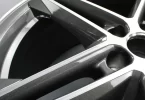Removing scratches from diamond cut alloy wheels is a meticulous process that requires a careful approach to restore the wheels’ appearance without causing further damage. Diamond cut alloy wheels have a distinctive, shiny finish achieved through precision machining, which makes scratch removal a bit more challenging than with standard alloy wheels. Here’s a step-by-step guide on how to remove scratches from diamond cut alloy wheels effectively.
Step 1: Assess the Damage
Before starting any repair work, thoroughly clean the wheels to remove dirt and grime. Use a mild wheel cleaner and a soft brush to ensure all debris is gone. Once the wheels are clean, inspect the scratches to determine their depth. Light surface scratches can often be polished out, but deeper scratches may require professional intervention.
Step 2: Gather Necessary Tools and Materials
To remove scratches from diamond cut alloy wheels, you’ll need the following items:
- Mild wheel cleaner
- Soft cloths and brushes
- Sandpaper (various grits)
- Polishing compound
- Clear coat lacquer
- Masking tape
- Wheel repair kit (optional)
Step 3: Clean the Wheels Thoroughly
Start by cleaning the wheels using the mild wheel cleaner and a soft brush. Ensure all dirt and brake dust are removed. This step is crucial as any debris left on the surface can cause additional scratches during the repair process.
Step 4: Mask Off the Wheel
Using masking tape, cover the tire and any parts of the wheel that are not scratched. This will protect these areas from accidental damage during the repair process.
Step 5: Sanding the Scratched Area
Begin with the least abrasive sandpaper, usually 600-grit, and gently sand the scratched area. Use a circular motion and apply even pressure to avoid creating flat spots on the wheel. If the scratch is deeper, you may need to start with a lower grit sandpaper, such as 400-grit, and then move to finer grits. Progressively use finer sandpaper (up to 2000-grit) to smooth out the surface.
Step 6: Polishing the Sanded Area
Once the scratches have been smoothed out, use a polishing compound to restore the wheel’s shine. Apply the compound to a soft cloth and rub it into the sanded area using a circular motion. Continue polishing until the area blends seamlessly with the rest of the wheel.
Step 7: Applying Clear Coat Lacquer
To protect the newly polished area and restore the original glossy finish, apply a clear coat lacquer. Follow the manufacturer’s instructions for application, usually involving spraying an even layer over the polished area. Allow the lacquer to dry completely, which may take several hours.
Step 8: Final Touches
After the clear coat has dried, inspect the wheel to ensure the scratch is no longer visible and the finish is consistent. If necessary, repeat the polishing process to achieve the desired shine. Finally, remove the masking tape and give the wheel a final clean to remove any residue from the repair process.
Professional Repair Options
For deep scratches or if you are unsure about performing the repair yourself, consider seeking professional help. Many automotive repair shops specialize in alloy wheel refurbishment and can restore your wheels to their original condition using specialized equipment and techniques.
Maintenance Tips
To keep your diamond cut alloy wheels looking their best, regularly clean them with a mild wheel cleaner and avoid harsh chemicals. Consider using a wheel sealant to protect the finish from future damage.
By following these steps, you can effectively remove scratches from diamond cut alloy wheels and restore their pristine appearance. However, remember that patience and attention to detail are key to achieving the best results.




